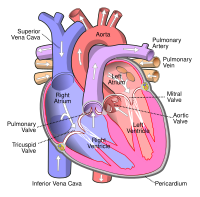
Photo from wikipedia
Background Transcatheter aortic valve replacement (TAVR) has been shown safe and feasible in patients with bicuspid aortic valve (BAV) morphology. Evaluation of inter-ethnic differences in valve morphology and function and… Click to show full abstract
Background Transcatheter aortic valve replacement (TAVR) has been shown safe and feasible in patients with bicuspid aortic valve (BAV) morphology. Evaluation of inter-ethnic differences in valve morphology and function and aortic root dimensions in patients with BAV is important for the worldwide spread of this therapy in this subgroup of patients. Comparisons between large European and Asian cohorts of patients with BAV have not been performed, and potential differences between populations may have important implications for TAVR. Aim The present study evaluated the differences in valve morphology and function and aortic root dimensions between two large cohorts of European and Asian patients with BAV. Methods and results Aortic valve morphology was defined on transthoracic echocardiography according to the number of commissures and raphe: type 0 = no raphe and two commissures, type 1 = one raphe and two commissures, type 2 = two raphes and one commissure. Aortic stenosis and regurgitation were graded according to current recommendations. For this study, aortic root dimensions were manually measured on transthoracic echocardiograms at the level of the aortic annulus, sinus of Valsalva (SOV), sinotubular junction (STJ), and ascending aorta (AA). Of 1427 patients with BAV (45.2 ± 18.1 years, 71.9% men), 794 (55.6%) were Europeans and 633 (44.4%) were Asians. The groups were comparable in age and proportion of male sex. Asians had higher prevalence of type 1 BAV with raphe between right and non-coronary cusps than Europeans (19.7% vs. 13.6%, respectively; P < 0.001), whereas the Europeans had higher prevalence of type 0 BAV (two commissures, no raphe) than Asians (14.5% vs. 6.8%, respectively; P < 0.001). The prevalence of moderate and severe aortic regurgitation was higher in Europeans than Asians (44.2% vs. 26.8%, respectively; P < 0.001) whereas there were no differences in BAV with normal function or aortic stenosis. After adjusting for demographics, comorbidities, and valve function, the dimensions of the aortic annulus [mean difference 1.17 mm/m2, 95% confidence interval (CI) 0.96-1.39], SOV (mean difference 1.86 mm/m2, 95% CI 1.47-2.24), STJ (mean difference 0.52 mm/m2, 95% CI 0.14-0.90) and AA (mean difference 1.05 mm/m2, 95% CI 0.57-1.52) were significantly larger among Asians compared with Europeans. Conclusions This large multicentre registry reports for the first time that Asians with BAV showed more frequently type 1 BAV (with fusion between right and non-coronary cusp) and have larger aortic dimensions than Europeans. These findings have important implications for prosthesis type and size selection for TAVR.
Journal Title: European Heart Journal
Year Published: 2018
Link to full text (if available)
Share on Social Media: Sign Up to like & get
recommendations!